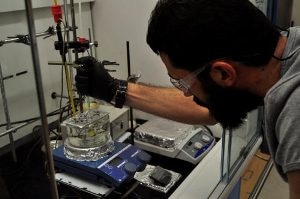Feb 24 2017
University of Arizona chemists hope to profit on the smelly remains of refined petroleum after discovering a way to turn sulfur into plastic infrared lenses.
 Ph.D. Student Metin Karayilan adds a compound to sulfur, preparing for a reaction. Photo by Nicholas Johnson/Arizona Sonora News
Ph.D. Student Metin Karayilan adds a compound to sulfur, preparing for a reaction. Photo by Nicholas Johnson/Arizona Sonora News
The process of hydro desulfurization was developed in the 1980s to remove sulfur from petroleum to prevent acid rain. In the years since, sulfur deposits have grown rapidly. The U.S goes through approximately 20 million barrels of oil a day. Five percent of every barrel of oil is sulfur.
The sulfur removed from petroleum is often stacked in large pyramid like deposits. Tons of pure elemental sulfur sits in these reservoirs, with minimal practical use. “We have more sulfur in the world then we know what to do with. We talk about this as one of the biggest environmental problems no one knows about,” said Research Chemistry Professor Jeffery Pyun.
While working on research to extend the life span of lithium-sulfur batteries Pyun and his research group developed a process called inverse vulcanization, and in turn a new type of plastic made from sulfur.
“The process that we describe as inverse vulcanization is a new sort of synthetic chemical methodology, so basically it’s a way of making polymers,”Pyun said. “What we do is we take a substance known as elemental sulfur, and we basically for the first time have found a one-step process to make a sulfur based plastic.”
The process Pyun refers to is adding a small amount of the chemical compound known as DIB to elemental sulfur. “If you melt sulfur and add a small amount of organic monomers, just carbon and nitrogen, you can actually make something that is stable,” said Tristan Kleine, a Ph.D. candidate working in Pyun’s lab.
Making these polymers stable was not an easy thing to do. “Sulfur likes to react with stuff, but it also likes to go back to elemental sulfur,” Kleine said. The polymers that Pyun’s lab makes are stable in their amorphous form. That means the sulfur been stretched out from its crystalline form until it becomes transparent. The example given by Kleine is that it’s “like a plastic bag. Plastic bags are opaque. When you stretch it, you can see through it. You’re taking that plastic bag from its crystalline form to its amorphous form.
Because these new polymers that Pyun’s lab produces are sulfur based, they have great optical properties in the infrared. Some possible uses include night vision goggles, and thermal imaging lenses for medical equipment.
“We have the very first plastic ever that can be used as lenses, or elements in IR imaging. Think about how many uses for plastics we have. If you have the first plastic that’s inexpensive and has amazing properties and function, that’s going to have technological relevance,” Pyun said.
Thermal imaging lenses in the market today are made with chalcogenides, toxic substances like arsenic and germanium. Chalcogenides melt at very high temperatures, and they aren’t soluble. Because chalcogenides are so difficult to work with the lenses produced from them can cost thousands of dollars. The plastic lenses Pyun’s lab makes from sulfur cost pennies on the dollar to make when compared to thermal imaging lenses being used today.
One thing Pyun seems interested in using these IR lenses for is thermal imaging lenses for cell phones. “In your smartphone you have all kinds of imaging and camera type applications if we’re successful we think that we could translate, for the first time, inexpensive IR imaging to a smartphone application,”Pyun said
While Pyun is talking with companies about potentially marketing some sort of product with these lenses he said “it would be professionally premature to discuss their early level interest…but certainly we have companies that are working with us.”
“If a doctor goes to Africa, he can’t bring his entire lab with him. He can’t bring an entire hospital worth of diagnostic tools with him. So they have to have something in the field that can easily do what all the big instruments in a hospital can do. Being able to miniaturize medical devices would be something our research could do, and that would be a way to bring a better point of care to Third World countries,” Kleine said.
Pyun is working with the Department of Defense, developing thermal imaging lenses for the military.
“It’s a very long process for something that we’ve developed in lab becomes industrially acquired. Typically, it takes about 15 years before something you’ve developed in lab goes to a mass production scale. Ultimately that is the goal, to see our stuff used industrially,” Kleine said.